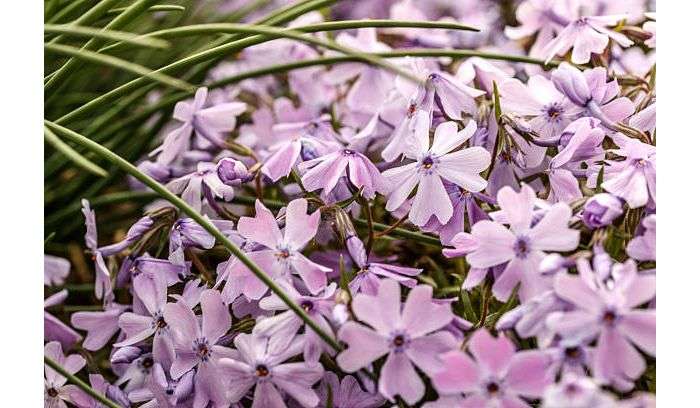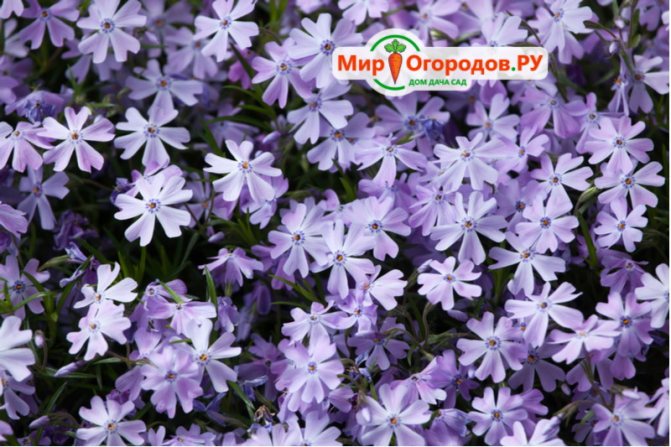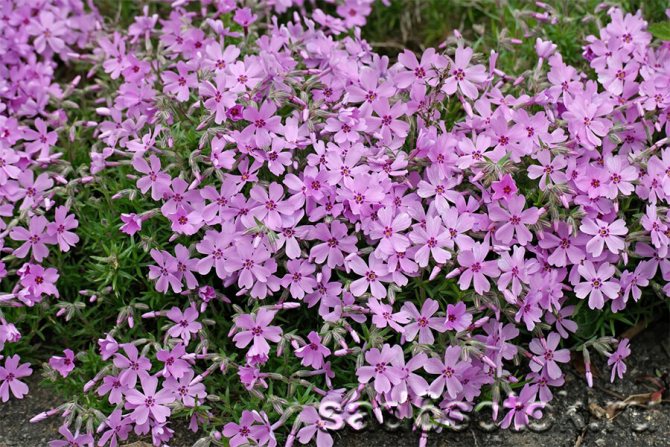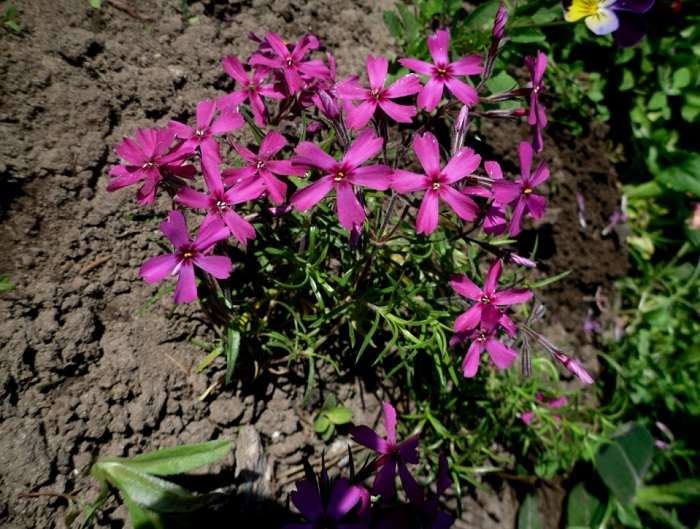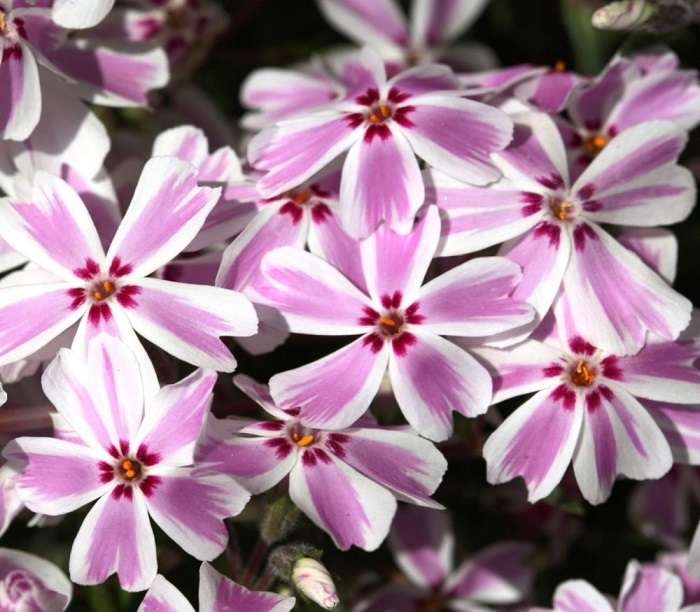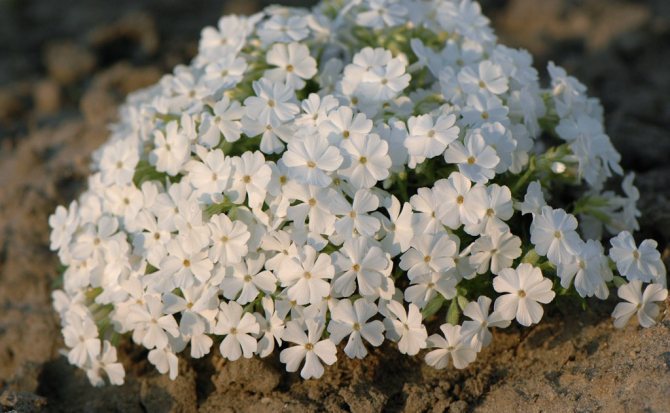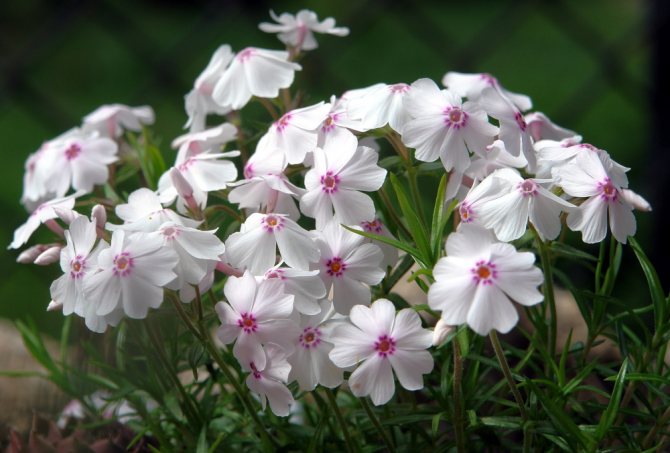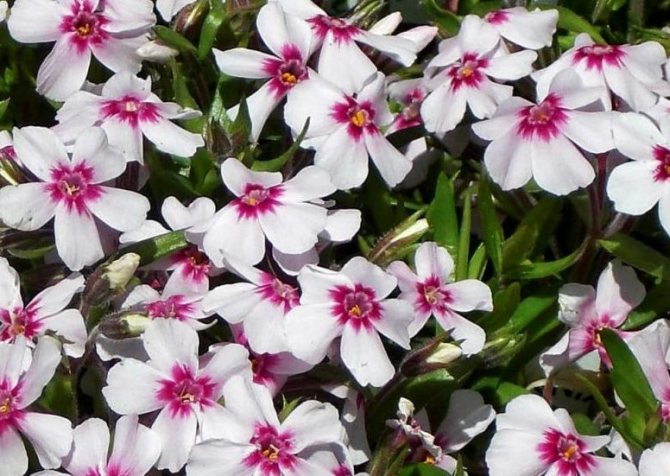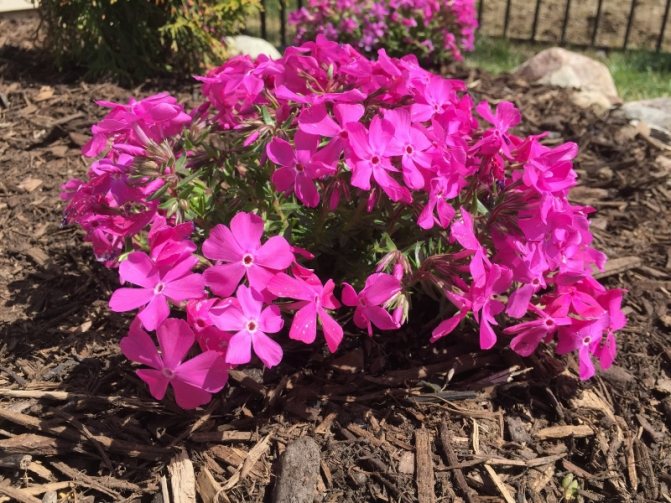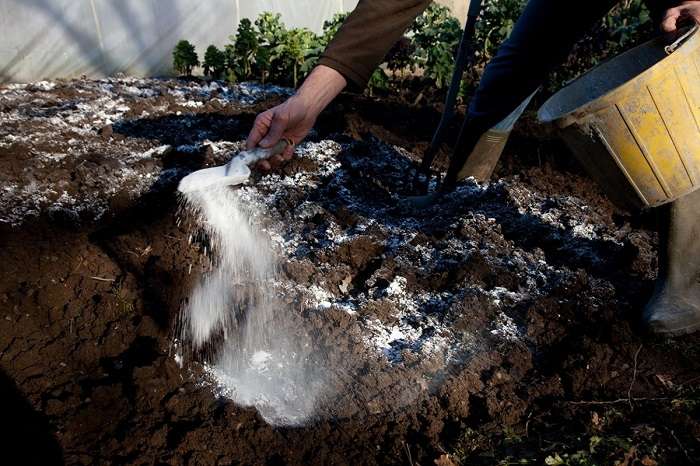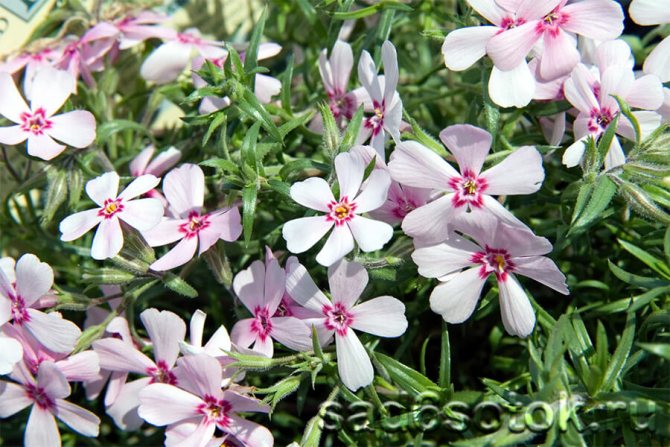Description of phlox subulate
Subulate phlox is a short (15–20 cm) plant with long, recumbent, creeping stems up to a meter long... Shoots are densely covered with small (1.5–2 cm), narrow, pointed, hard leathery leaves of a dark green color (for their resemblance to an awl, the plant got its name - subulate). Intertwining and densely branching stems consist of a large number of internodes, releasing roots from which the plant can additionally root.
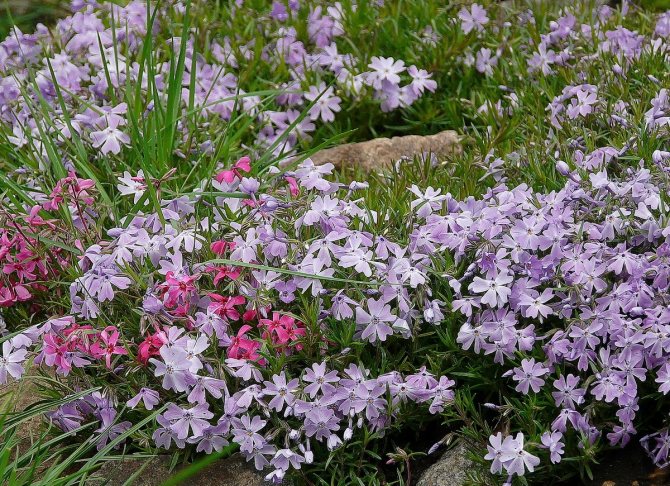
In the wild, phlox grows on rocky crumbling slopes
Inflorescences, consisting of 5-7 funnel-shaped five-petal small flowers, not exceeding 2 cm in diameter, are formed at the ends of shoots and from internodes. Notched at the edges, widely spaced petals come in a variety of shades (blue, cream, purple, bright red, pink, white, etc.)... Spring bloom, lasting from mid-May to early June, is very abundant. At this time, the flowerbed resembles a bright colored carpet. Some varieties can bloom again in August and September, but not so luxuriously.
Parents grow an awl-shaped phlox in the country. Even non-flowering, it looks extremely decorative. Moreover, the leaves remain green even under the snow.
Video: subulate phlox
How to plan a flower bed
A naturally beautiful plot or flower bed will not work if you do not plan everything in advance.
Considering that phlox belongs to creeping shrubs, it needs to be assigned an appropriate role. If you are planning a flower bed, in which there will be nothing except phlox, then there is nothing special to plan, you just need to plant in accordance with the recommendations.
But if the flower bed is located on an artificial elevation, next to the fountain and other elements, it is important to give the phlox its due place. For example, a popular solution when the subulate framing the flower bed around the perimeter. If the flowerbed rises, it beautifully beats the shape and continues to creep down.
Important! You need to plant phlox away from water - an excess can adversely affect development.


Phlox flower bed
Varieties of phlox subulate with a photo
Breeders from different countries have bred many interesting varieties and hybrids of subulate phlox. Consider a few of them that are most popular among gardeners and summer residents.
Bavaria
A short plant, growing up to 10–20 cm, strewn with an innumerable number of small (up to 2 cm) star-shaped flowers of a pure white color with a blue-violet eye in the center, from which thin lilac rays radiate along the petals. It blooms in mid-spring and occasionally in autumn, but not so abundantly.


Phlox varieties Bavaria (Bavaria), due to its unusual appearance, is often used to decorate rock gardens, mixborders and rabatok
Wilson
A vigorous shrub about 17–20 cm high, forming a dense evergreen rug. Peduncles, located at the ends of the stems, consist of 1–2 light blue (lavender) flowers 1.8 cm in diameter with a darker core. Spring bloom (May, June). The variety is considered one of the easiest to care for.


Phlox subulata Wilson (Phlox subulata G.F. Wilson) - ground cover early flowering perennial with dense leafy shoots
White Delight
Dwarf phlox, rarely exceeding 5-10 cm in height, grows well and quickly.White, slightly bluish, flowers up to 2.5 cm in diameter are collected in inflorescences of 5-7 pieces. Grows best on depleted and dry, but loose soils. On too fertile, oily soil, it produces many shoots, but few flowers.
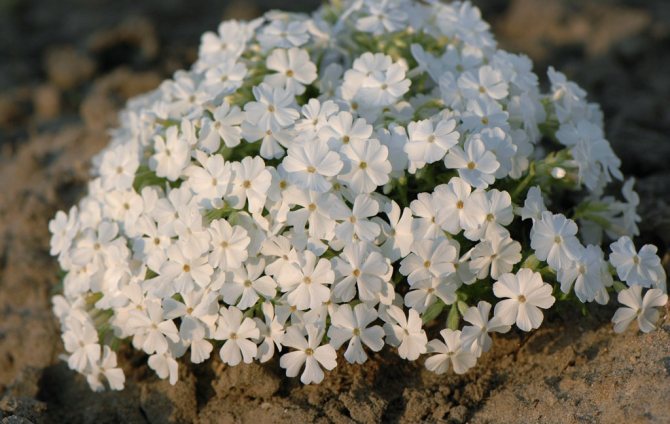

Phlox varieties White Delight (White Delight) is distinguished by its white flowers with a slight blueness
Candy Straps
A plant up to 15 cm high forming ground cover cushions. It grows extremely quickly, blooms extremely abundantly in spring. Original and unusual flowers up to 1.9 cm in diameter with delicate striped white-pink petals. Under favorable conditions, it can bloom again in September, opening individual buds until the very frost.
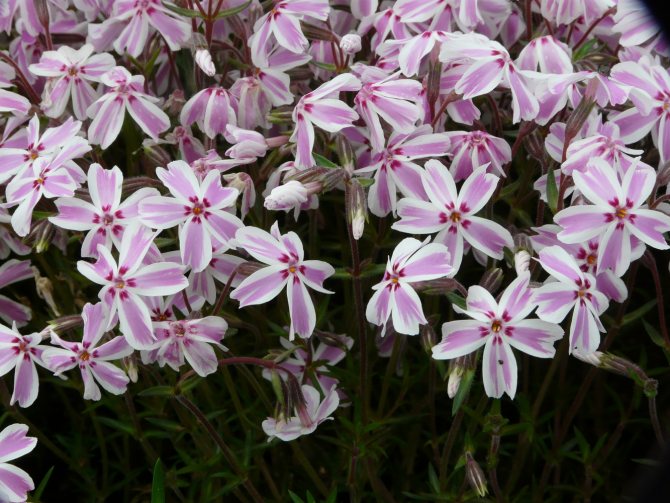

Candy Stripes (Candy Stripes) - the diameter of a white flower, which in the center of the petal has a wide pink stripe along its entire length, is 1.9 cm
Red Wings
An evergreen carpet-forming shrub about 17 cm high, densely covered with numerous small (up to 2.5 cm) saturated dark crimson flowers with a purple center. It blooms twice a season, but in autumn it is rather scarce with single flowers.


The variety "Red Wings" has numerous flowers, dark crimson with a purple eye, collected in small inflorescences
Crimson Beauty
Rapidly growing phlox forming a spectacular lavender sea, not exceeding 10-15 cm. Bright crimson-pink flowers with a dark purple center, 2-2.5 cm in diameter, collected in inflorescences of several pieces. It blooms in late spring and early summer.


Phlox Crimson Beauty has pink flowers with burgundy "strokes" closer to the center of the corolla
Use in design
The subulate phlox is a ground cover plant, so it is logical that it is used in landscape design mainly to fill the voids on the site. The plant quickly fills the space, transforming the garden, cultivating it.
The flower is also suitable for growing in mixboards, rockeries. Looks good on alpine slides, moreover, phlox grows well in rocky soil.
The flower can also be used as a border plant: it can border garden paths, gazebos, flower beds, flower beds. The plant also looks good in hanging containers: on the balcony, terrace, porch.
The phlox carpet looks great against the background of conifers. Compositions with other ground covers also look gorgeous: stonecrop, cereals, bells, rejuvenated, etc.
So, we learned what kind of plant is subulate phlox. This ground cover flower can turn an area into a solid bright carpet. Growing phlox is not difficult, and caring for it does not require much trouble - a beginner will also cope with the task.
Landing features
To ensure maximum flowering, subulate phlox should be planted in well-lit, slightly elevated areas, on dry, loose, aerobic sandy or loamy soils with neutral acidity.... It can grow in light shade, but bloom will be noticeably worse. But the culture does not tolerate the close location of groundwater, swampiness, stagnation of melt water and moisture at all.
Clayy, water-absorbing soils are loosened with sand and peat (bucket per 1 m2), making them crumbly. Too acidic soils are deoxidized with fluff (1-2 cups per 1 m2) or dolomite flour (200-400 g per 1 m2).


Subulate phlox can grow in light partial shade of large trees
The selected area is first dug up, carefully choosing the rhizomes of perennial weeds (loach, wheatgrass, etc.), while applying in very moderate quantities in order to prevent excessive growth of the green mass (for each m2):
- humus or compost (3-4 kg);
- crushed wood ash (50-60 g).
Landing technology:
- The holes are not dug too deep (5–15 cm), since the root system of the phlox is rather superficial.
- Leave at least 25–30 cm between individual specimens, as the plants grow rather quickly.
- Drainage from expanded clay or pebbles (3-4 cm) must be poured at the bottom.
- The bushes are laid out, carefully straightening the roots.
- Then sprinkle with soil mixture and compact.
- Water and mulch with humus, peat, etc.
Phlox subulate reproduces in several ways:
- Seeds. Least rarely used method... Seed material is sown before winter in bowls with a loose soil mixture, then put in a cool place for stratification (you can do without it). In the spring, at the stage of 4–5 true leaves, the seedlings are planted in a permanent place.
- Cuttings. Cuttings are harvested in spring and summer, any shoot, even an accidentally broken off, will do. The cut material is stuck into a moistened substrate of sand and peat, covered with jars or cut plastic bottles to create a greenhouse effect. After 1-2 weeks, the cuttings take root, the shelter can be removed. In the fall or spring of next year, determine the flower bed.
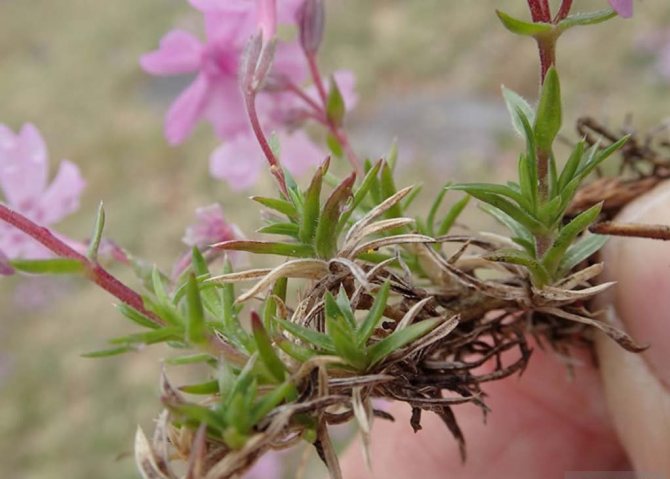

Phlox cuttings root very quickly
- By dividing the bush. Large adult bushes are dug up and divided into parts, each of which should have its own root system... Then they are planted in the right places.
- Rooting shoots. The shoot is bent down, pinned to the ground, sprinkled with soil in this place and watered. After rooting, they are separated from the mother plant.
Very often, it is not required to specially lay phlox shoots on the ground, because they themselves easily take root, after all, the lashes spread and crawl in different directions. I take such planting material in the fall, while the small bushes have not grown too much.
Video: planting and reproduction of subulate phlox
Possible breeding methods
An ornamental plant can be propagated in 4 ways:
- Seeds. This method is not very popular due to the small number of seeds in flowers. Usually the bush itself propagates by seeds fallen into the soil. If you managed to get phlox seeds, they should be planted in a greenhouse or cellar somewhere in the middle of autumn.
- The most common way is to divide the bush. A part of the bush, which has its own roots, is separated and planted in the right place. The most favorable time is April.
- Cuttings. Since the shrub takes root quite well, you can plant a cutting with small roots. They can be small parts left over, for example, after division.
- Rooting. An effective way for creeping bushes. The new branch is simply sprinkled with earth. There it will take root and become the center of a new bush.
In view of the good survival rate, all methods are quite effective and problems with the styloid variety usually do not arise.
Further care of the flower
Care for styloid phlox consists of the following simple procedures:
- Very moderate watering. One watering per week is usually sufficient (4–5 liters per bush). In drought, the bushes are moistened after 2-3 days. Use only lukewarm water, otherwise the stems will crack.
- Weeding and loosening. Weeds are removed regularly, the soil is loosened after each watering.
- Top dressing for 1 bush): before flowering - nitrogen-containing fertilizers (urea - 10-15 g, etc.);
- during budding and flowering - phosphorus-potassium complexes (superphosphate - 15–20 g, wood ash - 35–40 g, etc.);
- in the middle of summer - any complex mineral fertilizers for flowering garden crops (quantity according to instructions).
The best fertilizer for phlox is an infusion of wood ash. 0.3 kg of ash is poured into 2 liters of hot water, boiled for 7-10 minutes, cooled, filtered. Dilute in a ratio of 1:10 and water the bushes (1-2 liters per plant).
Video: caring for styloid phlox
Fertilizer for flowers
Perennial varieties of subulate phlox should be fed five times a season, annuals - four. Fertilizers can be applied according to a certain scheme.
- At the end of spring, ten liters of water - 25 g of liquid manure.
- In early June - the same fertilizer with superphosphate.
- In early July - liquid manure.
- At the end of July, fertilize with phosphorus salt and potassium, apply phosphorus-potassium fertilizing, it is best to do this in the evening.
Ash is also used as fertilizer. To do this, take 350 g of ash, pour two liters of water and boil for ten minutes, used for feeding both roots and leaves.
In order for phlox subulate to develop and grow faster at the end of winter, it must be watered with liquid humus.
Diseases and pests
The culture can be affected by some fungal diseases:
- Powdery mildew. The plantings are sprayed with Bordeaux liquid (1%), copper sulfate (3%).
- Rust. Use the drug Topaz, diluting the working solution according to the instructions.
- Fomozom. Treatment with colloidal sulfur (30–40 g per 10 liters of water) will help.
Of the insect pests, phlox are most often attacked by:
- Nematodes. Diseased specimens are dug up and destroyed. The rest for prophylaxis are treated with Depril, Nematol, etc.
- Caterpillars of the scoop. Sprayed with insecticides (Karate, Rovikurt, etc.).
- Slobbering penny. Insecticides are effective (Inta-Vir, Fufanon, etc.).


